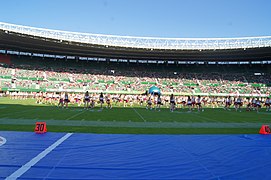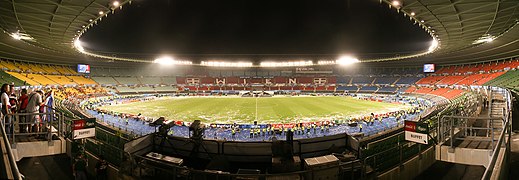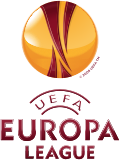Ernst Happel Stadium
| Ernst Happel Stadium | |
|---|---|

|
|
| West side of the Ernst Happel Stadium | |
| Earlier names | |
|
Prater Stadium (1931–1992) |
|
| Data | |
| place | Meiereistraße 7 1020 Vienna , Austria |
| Coordinates | 48 ° 12 '25.9 " N , 16 ° 25' 15.5" E |
| classification | 4th |
| owner | City vienna |
| start of building | 1929 |
| opening | July 11, 1931 |
| First game | Worker selection Vienna - worker selection Lower Austria 3: 2 |
| Renovations | 1945, 1956, 1965, 1984–1986, 2005–2008 |
| surface | Natural grass |
| costs | 39.6 million euros (renovation 2005-2008) |
| architect | Otto Ernst Swiss |
| capacity | 50,865 places (currently) 51,428 places ( EURO 2008 ) 92,708 places (1956) |
| playing area | 105 × 68 m |
| Societies) | |
| Events | |
|
|
The Ernst-Happel-Stadion (until 1992 Praterstadion , sometimes also called Wiener Stadion ) is a football stadium with an athletics facility in Leopoldstadt ( 2nd district of Vienna ) in the Austrian capital, Vienna . It is the national stadium and with 50,865 seats by far the largest stadium in Austria . The Ernst Happel Stadium is part of the UEFA Stadium Category 4 . The home games of the Austrian national soccer team and European Cup games of the Viennese clubs take place here. In addition, the ÖFB Cup finals and the Vienna City Derbies are occasionally held in the Ernst Happel Stadium. The sports facility was the venue for seven matches of the 2008 European Football Championship (including the final) and was extensively renovated with a view to the tournament.
The stadium is owned by the City of Vienna (Magistratsabteilung 51 - Sports Office of the City of Vienna).
Infrastructure
At concerts in the stadium, up to 19,000 seats can be added on the lawn . In addition to the sports facilities, offices for various municipal departments of the City of Vienna are located in an office building built around the stadium and partly under the stadium roof .
history
Until 1945
As early as 1915, the city of Vienna was considering building a central stadium. A number of designs were submitted, including a stadium with a swimming pool and car racing track at Schönbrunn's Fasangarten. Due to the war, however, it was not implemented. After the founding of the republic, there was again a major debate about the location. As alternatives to the Prater, the Hohe Warte , the Augarten and the remote Cobenzl were discussed.
The foundation stone was finally laid in November 1928 for the 10th anniversary of Austria's republic. The stadium was built between 1929 and 1931 according to plans by the Schramberg architect Otto Ernst Schweizer in 23 months and opened on July 11, 1931 on the occasion of the 2nd Workers' Olympics. Schweizer also built the stadium pool next to it (the largest outdoor pool in Europe with 400,000 m²). After its location in Vienna's Prater , the facility was originally called the Prater Stadium. At that time it was considered the most modern stadium in Europe, especially because of its short emptying time of only seven to eight minutes. Initially it had a total capacity of around 60,000 people. After its opening, political spectacles were held here in addition to sporting events .
During the Nazi era (1938–1945) the stadium was used for military purposes, as a barracks and planning office, and as a collection point for the deportation of Jews. Between September 11 and 13, 1939, after the attack on Poland began , over a thousand “Polish-born” Viennese Jews were taken into custody by order of Reinhard Heydrich . They were detained in the corridors of Sector B below the stands. The Natural History Museum Vienna carried out racial examinations ( craniometry (skull measurement), etc.) on 440 inmates from September 25 to 30 . On September 30, 1,038 prisoners were deported to the Buchenwald concentration camp . Football matches were held again in the stadium the very next day. 44 men were released in early 1940, 26 were liberated in 1945, the rest were murdered in concentration camps. In 1988 one of the surviving victims, Fritz Kleinmann, received compensation from the Austrian state for the amount equivalent to 62.50 euros for imprisonment in the stadium . In the VIP area, a memorial plaque created in 2003 on a private initiative commemorates the incidents.
In 1944 the stadium was badly damaged in bombing raids on the Wehrmacht's planning office.
Since 1945

After the end of the war and the reconstruction, the stadium was returned to its original sporting use.
In 1956 the capacity was increased to 92,708 people through extensions by Theodor Schöll, which was reduced again in 1965. The attendance record was achieved with 90,726 spectators on October 30, 1960 at the international soccer match Austria-Spain (3-0).
From 1984 to 1986 the spectator seats were roofed over. To reopen, a friendly game against Germany was played, which Austria won 4-1. After the death of the former top Austrian player and coach Ernst Happel , the stadium was named after him in 1992.
1964 ( Inter Milan - Real Madrid 3: 1, 72,000 spectators), 1987 ( FC Porto - FC Bayern Munich 2: 1, 58,000), 1990 ( AC Milan - Benfica Lisbon 1: 0, 57,500) and 1995 ( Ajax Amsterdam - AC Milan 1: 0, 49,730) the final of the UEFA Champions League (until 1992 European Champion's Cup) was played in the Ernst Happel Stadium.
The final of the European Cup Winners' Cup 1969/70 between Manchester City and Górnik Zabrze (2-1) was also held in the Prater Stadium. In contrast to the finals of the UEFA Champions League and the Champions Cup, it was not sold out with 7,968 spectators, which was also due to the rainy weather.
From 2014 to summer 2016, SK Rapid Wien competed temporarily in the Happel Stadium, as the old Gerhard Hanappi Stadium was replaced by the new Allianz Stadium . The FK Austria Wien more during the reconstruction of the Generali Arena from 2016 up to the re-opening of the arena in 2018 in the great Vienna Stadium of.
European Football Championship 2008
At the 2008 European Football Championship, the stadium hosted the final. Before that, the three group matches of the Austrian national team , two quarter-finals and one semi-final match were played in Vienna. With a view to the tournament, additional rows of seats were installed in the first and second tier, increasing the stadium capacity to 53,008 seats. The new rows of seats in the first tier had to be removed after the European Championships because the athletics association insisted on using the running track . The row of seats in the 2nd tier, however, was retained and increased capacity by 1,040 spectators.
As part of the renovation, it received underfloor heating in summer 2005 and a subway connection in May 2008 . Furthermore, the main media center and the stadium media center will be merged. For this purpose, a temporary extension with direct access to the stadium was built. New parking spaces have been created for VIP guests. Since special rooms with direct access to the interior of the stadium were required for the preparation of the closing ceremony, storage areas and offices also had to be built. The cost of the renovation was 39.6 million euros.
In order to ensure the safety of the European Championship 2008, to create the VIP parking spaces and to set up fan shops, 56 trees were felled around the stadium in November and December 8, 2006. This has been criticized in part because, although UEFA has required a safety zone, it has not explicitly required the felling of trees. The politicians in charge agreed to the felling of the trees, as the felling was unavoidable in view of the risk of terrorism that could not be ruled out and the safety of up to 1,500 possible injuries.
New build or modernization?
The Austrian football association ÖFB would like to replace the outdated Happel Stadium with a modern new building. As early as 2014, the association asked for a new stadium. On the other side there is politics with the city and the federal government, which favor a renovation. 40 million euros were invested in modernization for the 2008 European Football Championship. The ÖFB does not consider a further conversion to be sufficient. The Vienna City Councilor for Sports and Culture Andreas Mailath-Pokorny estimates the chances for a new national stadium to be rather low.
The ÖFB President Leo Windtner is committed to a pure football stadium for up to 60,000 seats. According to Stadionwelt, a construction of this size would cost over 100 million euros. The city of Vienna would have to bear the majority of the costs, as private financing would be possible, but difficult to implement. Since the major Viennese clubs SK Rapid ( Allianz Stadium ) and FK Austria ( Generali Arena ) will both play in their newly built or renovated stadiums from 2018, an average of only six international matches would take place in the new building each year. The final of the ÖFB Cup has taken place in the Klagenfurt Wörthersee Stadium in recent years . This would not be enough for private funding. President Windtner prefers a multifunctional arena that can also be used for concerts, trade fairs and other events. Because of the expected low use and the construction costs, critics consider a new national stadium to be a massive waste of state money.
In February 2017, the Vienna City Council rejected the construction of the new Happel Stadium. City councilor Mailath-Pokorny clearly rejected the new building plans. The city is currently examining the possibility of converting the sports facility that opened in 1931. A feasibility study is currently in progress. However, expansion or conversion is only possible if a sensible and affordable concept is available. Despite the cancellation, ÖFB President Windtner continues to hope for a new national stadium.
While the question of modernization or a new building is still open, the lease between the City of Vienna and the ÖFB has been extended. The agreement was signed on June 10, 2018, shortly before the international match against Brazil, by ÖFB President Leo Windtner and Vienna’s City Councilor Peter Hacker . This means that the Austrian national team will continue to play games in the Happel Stadium.
gallery
Final day of the 2014 European American Football Championship in the Ernst Happel Stadium
See also
- List of football stadiums in Austria
- List of the largest stadiums in Austria
- List of the largest football stadiums in Europe
- List of the largest football stadiums in the world
Web links
- wien.gv.at: Vienna Prater Stadium - Ernst Happel Stadium
- stadionwelt.de: Stadium guide
- stadiumdb.com: Ernst Happel Stadium (English)
- setlist.fm: Concert list of the Prater Stadium and the Ernst Happel Stadium (English)
Individual evidence
- ↑ See wien.gv.at: Wiener Praterstadion - Ernst-Happel-Stadion - Historic Sports Facility of the City of Vienna ( Memento from July 15, 2013 on WebCite )
- ↑ Cf. David Forster: Praterstadion prison ( Memento from June 4, 2009 in the Internet Archive ); on zdf.de, May 7, 2008
- ↑ 1969/70: City is waterproof ( Memento from January 5, 2013 in the Internet Archive )
- ↑ stadionwelt.de: Generali-Arena: Conversion on schedule, article from February 3, 2016
- ↑ stadionwelt.de: Ernst-Happel-Stadion: new building or renovation? Article dated August 23, 2016
- ↑ stadionwelt.de: ÖFB wants to build a new national stadium Article from November 16, 2016
- ^ Vienna.at: New construction of the Happel Stadium: Cancellation by City Councilor for Culture Mailath-Pokorny, article from February 22, 2017
- ↑ stadionwelt.de: No new construction of the Ernst Happel Stadium Article from February 23, 2017
- ↑ derstandard.at: Windtner: "Vienna would disappear from the football map" Article from February 23, 2017
- ↑ stadionwelt.de: Austria continues to play in the Happel Stadium Article from June 11, 2018











